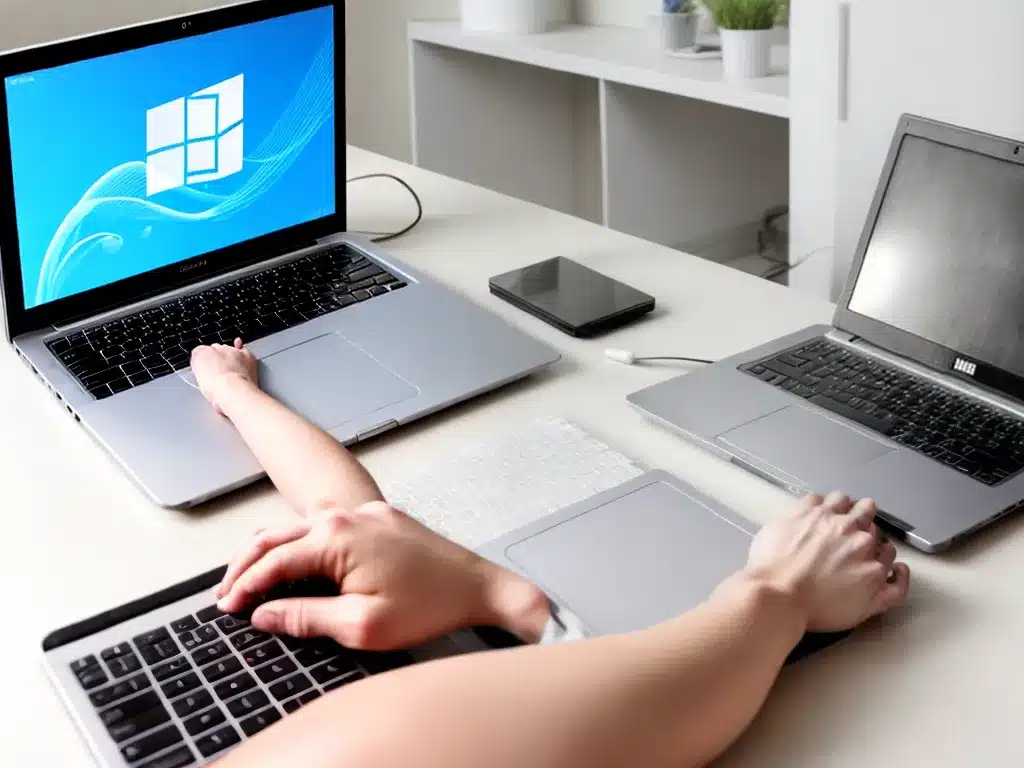
Keeping your laptop clean is one of the best ways to prevent it from overheating. Over time, dust and debris can build up and block the cooling vents, causing the internal components to heat up. An overheating laptop can suffer performance issues, system crashes, and hardware damage. The good news is that cleaning your laptop is easy. Follow the steps below to keep your laptop running cool and ensure its longevity.
Why Does My Laptop Overheat?
There are a few key reasons why laptops can overheat:
Dust Buildup
Dust, pet hair, crumbs, and other debris can accumulate and clog the air vents over time. This prevents airflow and causes heat to build up inside the chassis. The internal components can’t dissipate heat properly when airflow is blocked.
Faulty Fans
Most laptops rely on internal cooling fans to keep temperatures down. If the fans become obstructed or stop working, heat will rapidly build up. Fans may stop working due to dust buildup or mechanical failure.
Heavy Usage
Using resource-intensive programs can cause a spike in temperatures, especially for high performance components like the CPU and GPU. Gaming, video editing, and other demanding tasks generate more heat that has to be dissipated.
Poor Ventilation
Using a laptop on a soft surface like a pillow or bed can block the bottom vents. Lack of space around the laptop also prevents proper airflow. This leads to heat buildup over time.
How to Clean Your Laptop to Prevent Overheating
Cleaning your laptop regularly helps ensure proper ventilation and cooling. Follow these steps every few months to keep your system running cool:
1. Shut Down and Unplug the Laptop
Turn off your laptop and unplug the charger. Removing power prevents any electrical accidents while cleaning. Also, make sure to let the laptop cool down first if it feels hot.
2. Remove the Battery
If possible, remove the rear panel and take out the battery. This prevents accidental damage and lets you clean the battery compartment. Check your laptop manual for exact instructions.
3. Use Compressed Air
Use a can of compressed air to blow out vents and ports. Hold the can upright and spray short bursts to dislodge debris. Focus on the cooling vents on the bottom, sides, and rear.
4. Open Up the Case
For a deeper clean, use a Phillips-head screwdriver to open up the bottom case panel. This gives you access to the heatsinks, fans and internal components.
5. Clean Out Fans and Heatsinks
Use compressed air to thoroughly clean dust from any fans and heat sinks inside the laptop. Be careful not to dislodge or damage any small cables.
6. Remove Stuck Debris
If you see any clumped dust or debris stuck to components, use a cotton swab dipped in isopropyl alcohol to gently remove it. Let areas dry fully before reassembling.
7. Clean the Keyboard
Open up the laptop and flip the keyboard over. Use compressed air to blow out debris from between and under the keys. Q-tips and alcohol help remove grime buildup.
8. Wipe Down Exterior
Use a microfiber cloth to wipe down the outside of the closed laptop case. This keeps the surface clear of dust, fingerprints and residue. Avoid getting moisture in openings.
9. Reassemble Laptop
Put components back in place, reattach the battery, and screw the case back together. Make sure cables are seated properly and the case clips back on securely.
10. Update Drivers and Manage Software
Update your GPU, CPU and other hardware drivers after cleaning. Also uninstall or disable any unused programs to optimize performance. Manage resource-heavy software to prevent overtaxing your laptop.
Best Practices to Prevent Overheating
In addition to regular cleanings, you can take steps to keep your laptop running cool daily:
-
Give it space – Don’t block vents by using on a bed, pillow or other soft surface. Leave clearance around the laptop for airflow.
-
Clean out vents – Use compressed air to clear vents every month or so. This prevents gradual buildup.
-
Monitor temperatures – Use a hardware monitor to track component temps. Take action if CPU or GPU exceeds 85°C.
-
Use a cooling pad – An elevated pad with built-in fans helps increase airflow around the laptop.
-
Adjust power settings – Make sure your CPU does not run full throttle all the time. Manage performance vs cooling.
-
Update components – Improving thermal paste or pads between the CPU/GPU and heatsink improves heat transfer.
-
Limit intensive tasks – Don’t game or edit video for extended periods, which causes heat to spike. Give your laptop breaks.
With regular maintenance and care, you can prevent your laptop from overheating. Follow these cleaning tips and best practices to keep your system running smoothly for years before any need for repairs. Let me know if you have any other questions!












